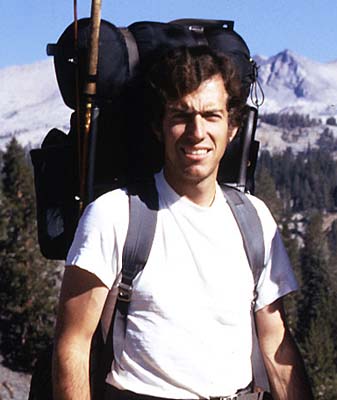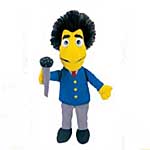 Brad
Schram is best known as one of the very active Santa Barbara County birders
in the late 1970s, and as the ebullient "Master of Ceremonies" around desert
campfires in those heady days. He actually appears in Audubon Field
Notes as early as fall 1966 (Red-necked Grebe in Santa Barbara), but
became more active during the 'golden years' of the late '70s, joining
Paul Lehman and Louis Bevier in vacuuming the county of its vagrants. Brad
'discovered' Carpinteria Creek mouth as a vagrant trap in 1977, and was
probably the first active birder to work the Santa Maria River mouth. He
was a member of the record-setting Santa Barbara County big day team: 179
species on 3 May 1977 (P. Lehman, L. Bevier, I. McGregor, B. Schram). He
and Paul co-organized the well-attended WFO conference in Santa Barbara
in '78. Brad
Schram is best known as one of the very active Santa Barbara County birders
in the late 1970s, and as the ebullient "Master of Ceremonies" around desert
campfires in those heady days. He actually appears in Audubon Field
Notes as early as fall 1966 (Red-necked Grebe in Santa Barbara), but
became more active during the 'golden years' of the late '70s, joining
Paul Lehman and Louis Bevier in vacuuming the county of its vagrants. Brad
'discovered' Carpinteria Creek mouth as a vagrant trap in 1977, and was
probably the first active birder to work the Santa Maria River mouth. He
was a member of the record-setting Santa Barbara County big day team: 179
species on 3 May 1977 (P. Lehman, L. Bevier, I. McGregor, B. Schram). He
and Paul co-organized the well-attended WFO conference in Santa Barbara
in '78.
The flyleaf to A Birder's Guide to Southern California (1998)
says: "Receiving $5.00 from his grandfather in 1961 as a high school graduation
present, Brad Schram purchased the newly published Second Edition of Peterson's
A
Field Guide to Western Birds and went birding." When asked about his
early days, Brad says that he started birding when about 9 years old, under
the tutelage of such old-time bird-watchers as Wyatt A. Kent of Los Angeles
and Dale T. Wood of Vista, CA. A native Californian, he gradually became
aware of migrations while haunting Buena Vista Lagoon in northern San Diego
County in the early and mid-sixties. [The best habitat there has been under
a shopping center since late '60s.] Brad moved to Santa Barbara in '66
and spent a lot of time at the Museum of Natural History where he met Richard
Webster and Louis Bevier, then high school students. He met Guy McCaskie
in 1970 on a CFO boat trip out of San Diego. "Joe Jehl was aboard with
a shotgun —he blasted an immature Long-tailed Jaeger from above our heads,"
recalls Brad, outraging some of those aboard.
In about '71 or '72 Brad became aware that Richard and Louis were finding
birds like American Redstarts, Blackpolls, and Bobolinks in fall in Goleta.
"After initial disbelief (my field guide didn't show them in our range)
I started looking for these things. They really were finding them!" recalls
Brad. He became hooked, and was not only a fixture at Santa Barbara vagrant
spots in fall, but by 1976 was undertaking treks to desert oases each Memorial
Day weekend and birding the entire State.
Photo of Brad with backpack in Yosemite is from 1972
|
 Brad
moved to San Juan Capistrano from 1980-1982, where his regular surveys
of Doheny State Beach put it on the Orange County birding map. He then
moved to Arroyo Grande, San Luis Obispo County in '83. Brad's greatest
contribution may have been the discovery of Oceano Campground, Pismo Beach
State Park as a vagrant trap. By '83 most SLO's migrant traps were known,
and Brad was told on arrival that no one ever birded Oceano because "no
one ever found anything in the willows" there. Birding it regularly in
fall '84, Brad found many vagrants his first year, including a Connecticut
Warbler. He has birded Oceano every fall since, and finds included another
immature Connecticut in fall of 1985. Since that time it's been birded
regularly, and has turned up such astonishing vagrants as Arctic Warbler
(in the 1990s, after our period of review was over). He has also been a
frequent leader on pelagic trips from this part of the central California
coast. Brad now holds the highest San Luis Obispo and Santa Barbara county
lists. Brad
moved to San Juan Capistrano from 1980-1982, where his regular surveys
of Doheny State Beach put it on the Orange County birding map. He then
moved to Arroyo Grande, San Luis Obispo County in '83. Brad's greatest
contribution may have been the discovery of Oceano Campground, Pismo Beach
State Park as a vagrant trap. By '83 most SLO's migrant traps were known,
and Brad was told on arrival that no one ever birded Oceano because "no
one ever found anything in the willows" there. Birding it regularly in
fall '84, Brad found many vagrants his first year, including a Connecticut
Warbler. He has birded Oceano every fall since, and finds included another
immature Connecticut in fall of 1985. Since that time it's been birded
regularly, and has turned up such astonishing vagrants as Arctic Warbler
(in the 1990s, after our period of review was over). He has also been a
frequent leader on pelagic trips from this part of the central California
coast. Brad now holds the highest San Luis Obispo and Santa Barbara county
lists.
As one might expect from the Master of Ceremonies, Brad is full of stories.
He tells this one about the October 1985 Spotted Redshank in the Santa
Maria River valley:
| "My seeing this bird was the result of my favorite 'work' message of
all time, left for me at PacBell. I'd been out for lunch with a client
— this was before voice mail or, blissfully, cell phones. I'd forwarded
my phone line while out to the Monterey PacBell office. On return from
lunch, I called Monterey for my messages. The clerk read them to me over
the phone and then said, rather cryptically, "Lynn (my counterpart in Monterey)
wants to read you the last one." "Okay," says I to Lynn, "shoot." He said:
"We want to know what this REALLY means!: 'Louis Bevier called. He said
he just found a Spotted Redshank in the sheep pasture behind the Santa
Maria sewage plant.' Now what DOES that mean?"
I replied: "It means you've got my calls until tomorrow!" I left
for Santa Maria. |
Since retiring from business, Brad now works part-time as a tour leader
for Victor Emanuel Nature Tours. Between 1998 and 2003 Brad served as a
naturalist aboard Society Expedition's adventure cruise ship World Discoverer
for
a few weeks each year. He cumulatively spent seven months at sea
these years in Arctic, Antarctic and West and South Pacific waters —birding..
Photo of Brad holding Least Bittern is from Goleta SBA
spring 1979; photo by Larry Ballard
|

Official Bird Name: Master of Ceremonies
Ticky Token: Yes
Significant bird records: Many local rarities, vagrants, and first
county records in coastal southern California (Orange to San Luis Obispo
counties), and of statewide interest
-
Trumpeter Swan 13 Jan 1973 Carrizo Plain SLO — 3rd CA rec,
first in southern CA
-
Roseate Spoonbill 30 July 1973 Goleta SBA — at the time, almost
the northernmost rec for CA
|
Selected publications 1973-1989:
-
Schram, B. 1973. A Trumpeter Swan in southern California. West. Birds 4:111.
-
Schram, B. 1978. Birding in Santa Barbara. West. Tanager 43(8): 1-4.
-
Lehman, P., and Schram, B. 1979. The changing seasons — summer 1979. Amer.
Birds 33: 839-844.
-
Schram, B. 1985. Mahoney's Curlew. Birding 17:15-18.
 Selected
publications since 1989: Selected
publications since 1989:
-
Schram, B. 1992. The joy of birding: the Cassowary. Birding 24: 268-271.
-
Schram, B. 1994. An open solicitation for cowbird recipes. Birding 26:
254-257.
-
Schram, B. 1998. A Birder's Guide to Southern California. Amer. Birding
Ass'n, Colorado Springs, CO.
More recent photo 22 Nov 1997 Tijuana R. mouth SD ©
D. Roberson |

 Selected
publications since 1989:
Selected
publications since 1989: